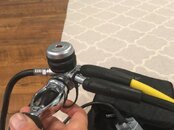If the backup didn't freeflow then it wasn't a major first stage failure. The most likely causes were either:
- bit of sand or grit that kept the 2nd stage valve from completely closing.
- first stage intermediate pressure (IP) that was higher than spec. If it went high enough, it would overcome the second stage valve spring pressure and start flowing.
The only way to be sure which it was is to check the IP value on the first stage. You do this by attaching an IP gauge to the LPI hose from your first stage and opening your tank valve. What you want to see is something in the range that Zef showed above. And then you wait. The IP might increase a tiny bit in the first minute or two but should be rock solid after that. A gradual increase in the IP pressure after that is what we call IP creep. You'll need to get the first stage serviced if the initial IP is too high or the IP creeps.
It's really worth getting an IP gauge. A basic one like the one pictured below is $10-$20 and can save you from paying for an unnecessary service or an aborted dive.

- bit of sand or grit that kept the 2nd stage valve from completely closing.
- first stage intermediate pressure (IP) that was higher than spec. If it went high enough, it would overcome the second stage valve spring pressure and start flowing.
The only way to be sure which it was is to check the IP value on the first stage. You do this by attaching an IP gauge to the LPI hose from your first stage and opening your tank valve. What you want to see is something in the range that Zef showed above. And then you wait. The IP might increase a tiny bit in the first minute or two but should be rock solid after that. A gradual increase in the IP pressure after that is what we call IP creep. You'll need to get the first stage serviced if the initial IP is too high or the IP creeps.
It's really worth getting an IP gauge. A basic one like the one pictured below is $10-$20 and can save you from paying for an unnecessary service or an aborted dive.




